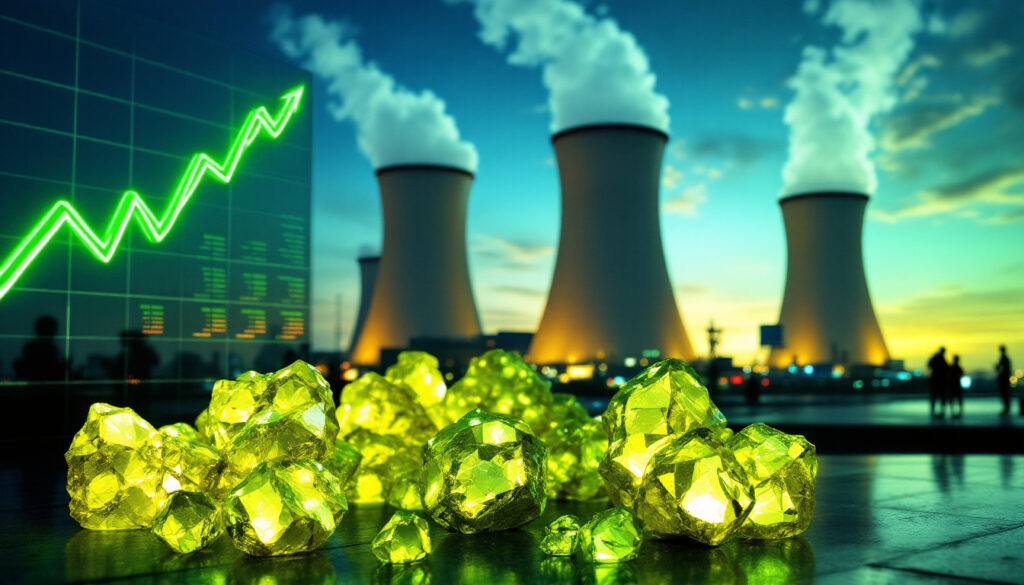Why Are Uranium Stocks Making a Comeback in Investors' Portfolios?
The Recent Uranium Price Recovery
The uranium market is experiencing a notable revival, with spot prices climbing back to US$70/lb after months of stagnation. This recovery follows a peak of US$107/lb in January 2023—a decade high—before prices retreated significantly. What's particularly encouraging for investors is that contract prices have maintained stability around the US$80/lb range despite earlier market pressures.
Market analysts are increasingly confident about uranium's trajectory, projecting long-term price stabilization in the US$75-80/lb range. Some even suggest the potential for short-term price spikes above US$100/lb during the ongoing market rebalancing phase, creating potential opportunities for well-positioned investors.
"The fundamentals for uranium remain exceptionally strong," notes David Franklyn of Argonaut Funds Management. "We're seeing utilities that had previously expected new production to come online now facing the reality of significant project delays, which is forcing them back to the contracting table."
What's Driving the Current Uranium Market Rebound?
At the heart of uranium's resurgence is a persistent and growing supply-demand imbalance. The global uranium market is currently experiencing a substantial 50-60 million pound annual deficit, with approximately 156 million pounds produced worldwide last year—significantly below consumption needs.
This deficit persists despite utilities previously accessing cheaper spot market material during the extended bear market. However, that inventory drawdown strategy has largely run its course, with accessible secondary supplies dwindling rapidly.
The supply crunch has been exacerbated by new production projects facing delays and slower-than-anticipated ramp-ups. Major projects from NexGen, Denison, Paladin, and Boss Energy are progressing more slowly than the market had anticipated, extending the supply shortfall timeline.
A significant development came when the Sprott Physical Uranium Trust completed a US$25.55 million private placement, effectively removing a market overhang that had been weighing on prices. This institutional confidence signal has helped stabilize the market and contributed to renewed investor interest in why uranium stocks could be back in investors' good books.
Understanding the Supply-Demand Imbalance
The current market dynamics represent a fundamental shift from the post-Fukushima era of oversupply. Global uranium production capacity has been significantly reduced over the past decade through mine closures and reduced output at existing operations.
Meanwhile, demand continues to strengthen, with 2024 marking the strongest uranium contracting year in over a decade. Utilities are now actively issuing expressions of interest for new contract volumes as they look to secure supplies for the coming decade.
This contracting surge reflects growing awareness among utility fuel buyers that the uranium market is transitioning from a period of inventory drawdown to one requiring significant new primary production. However, bringing new mines online is neither quick nor straightforward, with permitting delays, operational challenges, and financing hurdles creating a prolonged supply response.
"The market is in a structural deficit that isn't easily resolved. Even with all announced projects coming online as scheduled—which rarely happens in mining—we'd still be looking at years of undersupply."
Nuclear Energy's Expanding Global Footprint
The renaissance in uranium prices is underpinned by a broader revival in nuclear energy's prospects globally. After years of stagnation following the Fukushima disaster, nuclear power is gaining renewed recognition for its unique combination of reliability, energy density, and low carbon emissions.
This renewed interest is manifesting in concrete development plans, with approximately 65 new reactors currently under construction worldwide. The World Nuclear Association has forecasted a doubling of uranium demand by 2040, creating a long-term growth trajectory for the sector that hasn't been seen in generations.
How Is Nuclear Power Growing Worldwide?
Beyond traditional utility adoptions, a fascinating trend is emerging: tech giants are increasingly turning to nuclear power for their energy-intensive AI data centers. These facilities require enormous amounts of reliable, 24/7 electricity—precisely what nuclear excels at providing.
"The energy density and reliability of nuclear power make it ideal for applications requiring constant, uninterrupted power," explains Franklyn. "We're seeing major tech companies quietly securing nuclear power purchase agreements to ensure their AI operations have the necessary reliable electricity."
This tech industry adoption represents a potentially significant new demand source that many market forecasts haven't fully incorporated. With each large AI data center potentially consuming as much electricity as a small city, the scale of this emerging demand could be substantial.
The growing recognition of nuclear as a reliable, low-emission baseload power source comes as many countries face increased energy security concerns. The geopolitical tensions surrounding natural gas supplies in Europe have highlighted the vulnerability of depending on imported fossil fuels, driving interest in domestically-produced nuclear power.
Recent Policy Developments Supporting Nuclear Energy
Policy momentum is building significantly behind nuclear energy. The U.S. administration is reportedly preparing Executive Orders designed to accelerate reactor approvals, potentially using Department of Defense mechanisms to bypass traditional bureaucratic processes that have historically slowed nuclear development.
In a telling policy signal, uranium has remained exempt from recent US uranium tariff disruptions imposed on various commodities, underscoring its strategic importance to American energy security.
Meanwhile, the European Commission is developing a comprehensive roadmap to restrict Russian enriched uranium deals, reflecting both geopolitical concerns and a desire to develop more secure and diversified nuclear supply chains.
These policy shifts represent a significant departure from the post-Fukushima regulatory environment that hampered nuclear development for over a decade. The growing government recognition of nuclear's role in decarbonization strategies and energy security planning provides a more supportive backdrop for uranium market participants.
- EU taxonomy inclusion of nuclear as "sustainable investment"
- Japan's restart of reactors idled after Fukushima
- China's aggressive expansion of nuclear capacity
- UK's Hinkley Point C and Sizewell C development plans
- Canada's SMR (Small Modular Reactor) roadmap implementation
Major Players in the Uranium Market
The uranium production landscape is consolidating around a few dominant players, with three major producers emerging in Western markets: Kazatomprom (Kazakhstan), Cameco (Canada), and the soon-to-join NexGen Energy (Canada).
This concentration reflects the challenging economics of uranium mining, where only the highest-quality deposits or most efficient operations can deliver strong margins, particularly at current price points around US$70/lb.
Who Are the Leading Uranium Producers?
The current production landscape features established players alongside emerging companies:
- Kazatomprom: Kazakhstan's state producer controls approximately 40% of global uranium production through low-cost in-situ recovery operations
- Cameco: Canada's flagship producer operating high-grade mines including Cigar Lake (~15% U₃O₈)
- Boss Energy (ASX:BOE): Operating the Honeymoon mine in South Australia, producing 295,819 lb at US$21/lb C1 cost (Q1 2025)
- Paladin Energy (ASX:PDN): Running Langer Heinrich mine in Namibia, producing 745,484 lb at US$40.6/lb (Q1 2025)
- enCore Energy: Alta Mesa project (30% owned by Boss) delivering 130,015 lb at US$36.11/lb (Q1 2025)
What's particularly interesting for investors is the significant short positions that have built up on some ASX uranium stocks, with approximately 25% of Boss Energy shares held short. This positioning reflects market concerns about production costs and margins at the US$70/lb price point, but could also create future buying pressure if production targets are met and cost projections achieved.
What Makes Canadian Uranium Projects Stand Out?
The clear standout in the uranium production landscape is Saskatchewan's Athabasca Basin, which hosts exceptionally high-grade uranium deposits that dramatically outperform global averages:
| Company/Project | Grade (% U₃O₈) | Cost (US$/lb) |
|---|---|---|
| ISO Energy (Hurricane Zone) | 34.5% | N/A (Development) |
| Cameco (Cigar Lake) | ~15% | ~$15-18 |
| Cameco (McArthur River) | ~5% | ~$15-20 |
| NexGen (Arrow) | 3.1% | $7.58 (Projected) |
| Paladin (Langer Heinrich) | 0.07% | $40.6 |
| Boss (Honeymoon) | 0.04% | $21 |
| Deep Yellow | 0.03% | N/A (Development) |
| Bannerman | 0.02% | N/A (Development) |
NexGen's Arrow project exemplifies these advantages, containing 257 million pounds at 3.1% U₃O₈ (measured and indicated), with probable mineral reserves of 240 million pounds within 4.6 million tonnes at 2.37% U₃O₈. The project's production potential is impressive at 29 million pounds annually during the first five years.
The economic implications of these grade differences are substantial. NexGen's Rook I project has an estimated development cost of US$1.3 billion but projects operating costs of just US$7.58/lb—dramatically lower than Australian or African operations running at US$21-40/lb.
"Grade is king in uranium mining," emphasizes Franklyn. "A 1% U₃O₈ deposit yields approximately 22 times more uranium per tonne of rock processed than a 0.05% deposit, resulting in fundamentally different cost structures."
ISO Energy's Hurricane Zone project further demonstrates the Basin's exceptional grades, containing 48.6 million pounds at a remarkable 34.5% U₃O₈ (indicated), plus an additional 2.7 million pounds at 2.2% U₃O₈ (inferred). Located approximately 40km from the existing Maclean Lake mill, the project benefits from established infrastructure in the region.
Investment Opportunities in Uranium Stocks
The uranium equity landscape offers various entry points for investors, depending on risk tolerance and investment horizon. The sector spans from established producers with stable cash flows to exploration companies with significant upside potential but higher risk profiles.
Which Uranium Companies Show Promise?
NexGen Energy (ASX:NXG) stands out as potentially joining the ranks of major global producers. The company is developing the massive Rook I project in Saskatchewan's Athabasca Basin, with economics that could make it one of the world's lowest-cost uranium operations.
The company also holds approximately a 32% stake in ISO Energy, which owns the Hurricane Zone project containing some of the highest-grade uranium mineralization ever discovered. This provides investors with exposure to both near-term production potential and exploration upside.
Australian producers have demonstrated improving production metrics in recent quarters:
- Boss Energy's Honeymoon mine has achieved production of 295,819 lb at US$21/lb C1 cost
- Paladin Energy halts uranium mining in Namibia has been a significant development, though its Langer Heinrich operation previously delivered 745,484 lb at US$40.6/lb
- Both companies are working to optimize operations and reduce costs
The significant short positions in companies like Boss Energy (approximately 25% of outstanding shares) create an interesting dynamic where production achievements could trigger covering activity and drive share prices higher.
"There's substantial skepticism about the ability of some Australian producers to generate adequate margins at current prices. However, if they can demonstrate production consistency and cost control, those short positions could become a source of buying pressure."
How Do Uranium Stock Economics Compare?
The economics of uranium projects vary dramatically based primarily on three factors: resource grade, mining method, and jurisdiction. Canadian high-grade deposits maintain significant advantages across various uranium price scenarios:
| Project | Breakeven Price | NPV at $75/lb | IRR at $75/lb |
|---|---|---|---|
| NexGen (Rook I) | ~$30/lb | $3.5B | 52.4% |
| ISO Energy (Hurricane) | ~$35/lb | N/A | N/A |
| Paladin (Langer Heinrich) | ~$55/lb | $476M | 31.5% |
| Boss (Honeymoon) | ~$50/lb | $412M | 47% |
| Deep Yellow (Tumas) | ~$60/lb | $352M | 25.8% |
Capital requirements for project development also vary significantly. NexGen's Rook I requires approximately US$1.3 billion but could produce 29 million pounds annually for the first five years. By comparison, many Australian and African projects require $100-300 million but might produce 2-3 million pounds annually.
Jurisdictional factors also play an important role in project economics. Saskatchewan offers established infrastructure, experienced workforce, and a stable regulatory environment, while some African jurisdictions present additional risks that can affect both financing costs and operational stability.
Market Catalysts and Risk Factors
Understanding both potential catalysts and risk factors is crucial for investors considering uranium exposure. The sector offers significant upside potential but comes with unique challenges that require careful assessment.
What Could Drive Uranium Stocks Higher?
Several potential catalysts could accelerate uranium price appreciation and equity performance:
- Utility Contracting Activity: Accelerating long-term contracts as uncovered utility requirements grow
- Policy Announcements: Additional governmental support for nuclear energy expansion
- Short Covering: Particularly relevant for heavily shorted stocks like Boss Energy
- Production Milestones: Successful ramp-ups at new or restarted mines demonstrating viability
- Merger and Acquisition Activity: Sector consolidation as larger players acquire quality assets
The recent US$25.55 million private placement by Sprott Physical Uranium Trust has helped remove a market overhang, creating a more favorable environment for price appreciation. Additionally, the continued progress of NexGen's Rook I project through permitting represents a significant potential catalyst as it approaches construction decision.
What Risks Should Uranium Investors Monitor?
The uranium sector presents several specific risk factors that investors should carefully consider:
- Permitting Timelines: Regulatory delays can significantly impact project economics, particularly in jurisdictions with complex approval processes
- Production Ramp-Up Challenges: Technical difficulties during mine restarts or new mine commissioning are common
- Cost Inflation: Rising input costs for energy, labor, and materials can erode project margins
- Uranium market volatility: Significant institutional short positions can create price volatility
- Geopolitical Considerations: Supply chain disruptions, particularly related to Russian conversion and enrichment services
Canadian projects generally face fewer jurisdictional risks but must navigate a detailed regulatory framework. NexGen's Rook I project has hearings scheduled with the Canadian Nuclear Safety Commission for November 2025 and February 2026, representing critical milestones in its development timeline.
FAQ: Common Questions About Uranium Investments
Why has the uranium market been volatile recently?
The uranium market has experienced volatility due to a combination of factors, including shifting utility purchasing patterns, geopolitical tensions affecting supply chains, and delays in bringing new production online. The market is fundamentally transitioning from a period of inventory drawdown and oversupply to one of structural deficit, creating price discovery challenges.
Many utilities delayed contracting during the extended bear market, accessing cheaper spot material instead. As those inventories deplete and utilities return to long-term contracting, price discovery has become more volatile. Additionally, the unique nature of uranium—where neither producers nor utilities want to sell or buy at spot prices—creates a market dynamic unlike most commodities.
How does uranium grade affect mining economics?
Uranium grade dramatically impacts mining economics across all price scenarios. Higher-grade deposits (like those in Canada's Athabasca Basin) can remain profitable even at lower uranium prices due to significantly lower production costs per pound.
For example, NexGen's projected US$7.58/lb operating cost at Rook I is approximately one-third of Boss Energy's US$21/lb at Honeymoon, despite similar mining methods. This cost advantage derives primarily from the dramatic grade difference: 3.1% U₃O₈ versus 0.04% U₃O₈.
To put this in perspective, processing one tonne of 3.1% ore yields approximately 68 pounds of U₃O₈, while processing one tonne of 0.04% ore yields less than 1 pound. This translates directly to lower energy consumption, reduced chemical usage, less waste management, and ultimately much lower costs per pound produced.
What role will nuclear power play in the clean energy transition?
Nuclear power is increasingly recognized as a critical component of clean energy strategies due to its reliable baseload generation capacity, minimal carbon emissions, and small physical footprint. At approximately 12g CO₂/kWh lifecycle emissions (compared to coal's 820g CO₂/kWh), nuclear offers one of the lowest carbon solutions for electricity generation.
The technology complements intermittent renewable sources by providing stable baseload power regardless of weather conditions. This reliability factor is gaining renewed appreciation as grid stability challenges emerge in regions with high renewable penetration.
Nuclear is also gaining support for powering energy-intensive applications like AI data centers, which require 24/7 reliable electricity at scale. Major technology companies are increasingly exploring nuclear power purchase agreements to support their expanding computational demands.
How might geopolitical factors impact uranium investments?
Geopolitical considerations significantly influence the uranium market. Western utilities are increasingly seeking to diversify away from Russian supply, creating opportunities for producers in stable jurisdictions like Australia
Want to Profit From the Next Major Mineral Discovery?
Stay ahead of the market with Discovery Alert's proprietary Discovery IQ model, which instantly identifies significant ASX mineral discoveries and transforms complex data into actionable investment opportunities. Explore how historic discoveries have generated substantial returns by visiting the dedicated discoveries page and start your 30-day free trial today.




